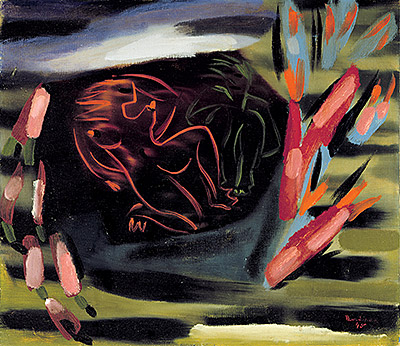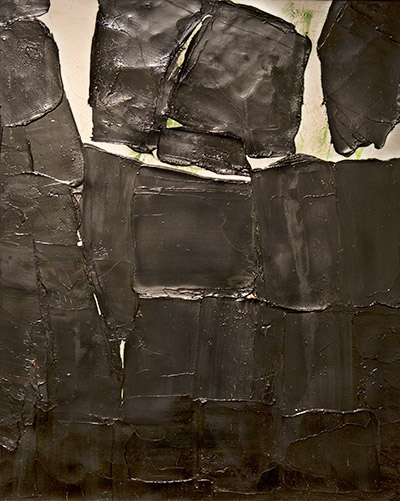In the House of Paul-Émile Borduas

Exploring Borduas' Art
Five Periods, Up Close

Angels announcing the good new to the shepherds, 1929
oil on cardboard
The Annunciation to the Shepherds, 1929
watercolour and lead pencil on white paper
After graduating from the École des beaux-arts de Montréal (fine arts school) Borduas taught for a short time, but soon left for France, where he continued his training in religious painting in 1929 and 1930. These two paintings correspond to the period marked by his first stay in France and the production of his youth. They are both the result of manatory exercises in the Ateliers d’art sacré (sacred art studios) in Paris.
The two works present the same theme, that of the angels appearing to shepherds to announce the birth of the Christ child. It is possible that the sketches are both the fruit of research and reflection on this subject for a single painting that Borduas intended to create. The two show the same basic composition, with a group of angels in the upper part of the painting and a group of shepherds in the lower part. However, in the sketch entitled Anges apprenant la bonne nouvelle aux bergers there are many more details that correspond to the text of the Gospel. The starry sky in this painting contrasts with the much darker one in L’Annonce aux bergers, in which the angel addressing the shepherds is much easier to recognize. The play of texture, colour and details in these two compositions show how Borduas was looking for a way to represent and organize a traditional subject in a truer, more contemporary manner.
TOP: Paul-Émile Borduas, The Annunciation to the Shepherds, 1929, watercolor and graphite on white paper. Collection of Renée Borduas. Photo MBAM, Brian Merrett. © Paul-Émile Borduas Estate / SODRAC (2013)
BOTTOM: Paul-Émile Borduas, Angels announcing the good new to the shepherds, 1929, oil on cardboard. Collection of Renée Borduas. Photo MBAM, Brian Merrett. © Paul-Émile Borduas Estate / SODRAC (2013)

Paul-Émile Borduas, Self-portrait, c.1928, oil on canvas.
Collection of the National Gallery of Canade,
gift of Mme Paul-Émile Borduas. Photo NGC.
© Paul-Émile Borduas Estate / SODRAC (2013)
Self-portrait, ca. 1928
oil on canvas
The date of this painting is uncertain. Borduas said that it was done in 1928, while certain art experts believe that it likely dates from the early 1930s. This self-portrait is fairly conventional in its form and composition. It shows obvious affinities with the Northern Romantic Tradition. Borduas’ later self-portraits clearly reflect his artistic evolution and integrate certain characteristics influenced by various styles of Modern painting, such as Cubism.
One thing is certain – a fascination with the human being imbues not only this work but also the artist’s entire production. Even though this portrait is an external image of a person, it contains some of the characteristic that Borduas sought to integrate in his painting: interiority, personality and singularity. Borduas’ work was always based on a quest for the essence of humanity and self-knowledge, both of which are important elements in any portrait: «The expression of the “interior world” makes no sense unless it has, and always has, the most exact relation possible with the visible. In this infinite visible world, we select the aspects that are the most noteworthy, the freshest or the most troubling. The adventure of consciousness continues without deviating. Either you are part of the adventure or you are not. »

Paul-Émile Borduas, « 2.45 » or "The Enchanted Island", 1945,
oil on canvas. Collection of the Montreal Museum of Fine Arts,
gift of the Succession J.A. DeSève. Photo MMFA, Marilyn Aitken
© Paul-Émile Borduas Estate / SODRAC (2013)
« 2.45 » or "The Enchanted Island", 1945,
oil on canvas
It seems that this painting went by different titles over the years. Borduas referred to it as L’Île du diable (Devil’s Island) in a grant application he made to the Guggenheim Museum in 1948, and as 2.44 ou L’Île approchée (The Approached Island) in the artist’s ledger.
The title L’Île enchantée was attributed definitively to the work in 1962, in a retrospective exhibition organized by the Montreal Museum of Fine Arts. Although this happened after the artist’s death in 1960, it does not mean that Borduas himself never thought of the painting in these terms. In fact, in an unpublished text “Ce destin fatalement s’accomplira”(This destiny will inevitably come to pass) – a draft version of the article “Manières de goûter à une oeuvre d’art” (Ways of savouring a work of art), published in the review Amérique française in January 1943 – he wrote:
«Once this end was achieved, we had only one desire, to fall happily asleep in this enchanting island of eternal repose. No pitfall caused us fear. Death itself was accepted joyously. When voices were raised, brave, lively and loud enough to cry, “Look out!” through their work, there was a scandal.»
The correspondence between Borduas’ words and the work is interesting, for both confirm how modern and contemporary art was undergoing an explosion of freedom. This painting was a harbinger, coming right before the period in which Borduas did abstract landscapes, which marked much of his production between the years 1946 and 1950. L’Île enchantée, or enchanteresse exemplifies an image of an almost perfect place in this stage in Borduas’ evolution as a painter, a period in which the artist sought to attain the inner landscape that dwelled within him and to let it find spontaneous expression. It might be noted that a painting by Ozias Leduc bears the same title. The reference to the master’s work may be merely circumstantial, but it remains symbolically very evocative.

Paul-Émile Borduas, Blue drops, 1955, oil on canvas.
Collection of the Montreal Museum of Fine Arts,
gift from Dr et de Mme Max Stern.
Photo: Luc Bouvrette.
© Paul-Émile Borduas Estate / SODRAC (2013)
Blue Drops, 1955
oil on canvas
This painting displays the main characteristics of Borduas’ work during his stay in New York, in the first part of the travels that would eventually take him to Paris. These works are marked by light-filled white backgrounds from which there emerge patches and shapes of vivid colour. Here, the colour blue predominates on a luminous background. This painting is an eloquent example of Borduas’ New York production. The material plays an important role, the splashes of colour are scattered over the canvas in the “all over” or “drip” manner of Jackson Pollock and other American artists of the time and the use of colour is balanced and controlled. The work also contains echoes of the action painting methods used by American Abstract Expressionists living in New York when Borduas was there: «What would they say now – those who visited Borduas in Provincetown last summer and thought that his paintings had become entirely white, an inanimate white, with a degree of abstraction far beyond the limits reached by Mondrian? Those canvases look sombre compared the New York paintings, which are materially just as rich, and Borduas has never been less abstract nor more faithful to all the solicitations of life – and more lucid and attentive in his quest for intelligible expression.»

Paul-Émile Borduas, Composition 69, 1960, oil on canvas.
Collection of the Montreal Museum of Fine Arts, gift of Renée Borduas.
Photo Luc Bouvrette.
© Paul-Émile Borduas Estate / SODRAC (2013)
Composition 69, 1960
oil on canvas
Found on the easel in Borduas’ studio, the day after his death on February 22, 1960, this work is considered to be his last. This pictorial testament is characteristic of Borduas’ work in his last period in Paris. The pallette is reduced almost exclusively to black and white; simplicity and purity emanate from compositions in which dark forms calmly invade the luminous space of the canvas. These representations of darkness invading light correspond to a period of great solitude provoked by the artist himself. He cut himself off from public life, desperately awaiting recognition and glory. The poet Jean-Paul Filion, who went to Borduas’ studio on February 26, 1960, after the artist’s funeral, wrote: «The painting, not yet dry, that I see perched on the easel looks to me like the pure and simple representation of a true mortuary card. I will describe it: an immense single black mass covers almost the entire surface of the canvas, with, at the top, a narrow white horizon in which there floats a hint of limpid green and where the painter has stuck on two little black rectangular forms, thus creating a fascinating perspective towards space. What are they doing there… these two phantoms like the ends of a shroud that persist in taking up all the room in a restricted space of inaccessible light, placed like a heading at the summit of a high wall of gleaming coal? This leads me to see in this last work the illustration of a sort of despair experienced at the outer limits of the cosmos. Am I mistaken…? »
Header image: Paul-Émile Borduas painting in Gaspésie in 1938 (detail). Gilles Lapointe collection.

Watch these video clips about Blue drops (1955) and Black star (1957) presented by the art historian François-Marc Gagnon.
© Musée des beaux-arts de Mont-Saint-Hilaire, 2014.
All rights reserved.

